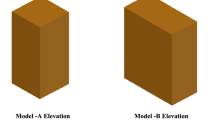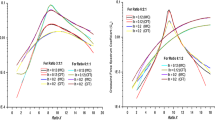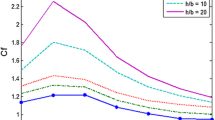Abstract
Nowadays, with the development of composite materials and construction technique, it is feasible to construct tall buildings to a desired height. In the design of tall buildings, wind loads are the major design criteria to be considered by structural engineers and architects. This paper explores the mean pressure coefficient (mean Cp) on pentagon plan shape building using artificial neural networks (ANN). The input for ANN is obtained by performing CFD simulation for the wind angles 0° to 180° at an interval of 15°. The Levenberg–Marquardt training function and mean square error (MSE) performance function are utilized to train the target data. The network is trained till the correlation (R) reaches between 0.9 and 1, respectively. The results have shown that the mean values of Cp obtained from CFD and ANN are in good agreement. Furthermore, mean pressure coefficient (Cp) for intermediate wind angles for pentagon plan shape building is obtained using ANN. A sample check is made on the wind angles 35° and 165°, and the obtained results are within the permissible limits.



























Similar content being viewed by others
References
K.B. Rajasekarababu, G. Vinayagamurthy, S. Selvi Rajen, Experimental and computational investigation of outdoor wind flow around setback building. Buil. Simul. 12(5), 891–904 (2018)
K.B. Rajasekarababu, G. Vinayagamurthy, CFD validation of wind pressure distribution on a tall building under the influence of upstream terrain. Prog. Comput. Fluid Dyn., Int. J. 20(5), 284–298 (2020)
P. Sanyal, S. Kumar Dalui, Effect of courtyard and opening on a rectangular plan shape tall building under wind load. Int. J. Adv. Struct. Eng. 10, 169–188 (2018)
S. Chakraborty, S. Kumar Dalui, A. Kumar Ahuja, Wind load on irregular plan shaped tall building – a case study. Wind. Struct. 19(1), 59–73 (2018)
B. Bhattacharyya, S. Kumar Dalui, Investigation of mean wind pressures on ‘E’ plan shaped tall building. Wind. Struct. 26(2), 99–114 (2018)
R. Paul, S. Kumar Dalui, Wind effects on ‘Z’ plan-shaped tall building: a case study. Int. J. Adv. Struct. Eng. 8, 319–335 (2016)
S. Mukherjee, S. Chakraborty, S. Kumar Dalui, A. Kumar Ahuja, Wind induced pressure on ‘Y’ plan shape tall building. Wind. Struct. 19(5), 523–540 (2014)
M. Mallick, A. Mohanta, A. Kumar, V. Raj, Modelling of wind pressure coefficient on C-Shaped building models. Model and Simul in Eng 6524945, 1–14 (2018)
V. Rajendran, P. Shanmugasundaram, Study on outdoor wind flow and mean wind pressure around the ‘T’ Plan shape tall building. J. Inst. Eng. India Ser. A (2022). https://doi.org/10.1007/s40030-021-00605-1
A.C. Khanduri, C. Bédard, T. Stathopoulos, Modelling wind-induced interference effects using backpropagation neural networks. J. Wind Eng. Ind. Aerodyn. 72, 71–79 (1997)
F. Bre, J.M. Gimenez, V.D. Fachinotti, Prediction of wind pressure coefficients on building surfaces using artificial neural networks”. Energy Build. 158, 1429–1441 (2018)
J.Y. Fu, S.G. Liang, Q.S. Li, Prediction of wind-induced pressures on a large gymnasium roof using artificial neural networks. Comput. Struct. 85, 179–192 (2007)
X. Gavalda, J. Ferrer-Gener, G.A. Kopp, F. Giralt, Interpolation of pressure coefficients for low-rise buildings of different plan dimensions and roof slopes using artificial neural networks. J. Wind Eng. Ind. Aerodyn. 99(5), 658–664 (2011)
Y. Chen, G.A. Kopp, D. Surry, Prediction of pressure coefficients on roofs of low buildings using artificial neural networks. J. Wind Eng. Ind. Aerodyn. 91(3), 423–441 (2003)
T.J. Nikose, R.S. Sonparote, Computing dynamic cross-wind response of tall building using artificial neural network. J. of Supercomput. 76, 3788–3813 (2018)
G. Hu, L. Liu, D. Tao, J. Song, K.T. Tse, K.C.S. Kwok, Deep learning-based investigation of wind pressures on tall building under interference effects. J. Wind Eng. Ind. Aerodyn. 201, 1–14 (2020)
A. Kumar Bairagi, S. Kumar Dalui, Forecasting of wind induced pressure on setback building using Artificial Neural Network. Periodica Polytechnica Civil Eng 64(3), 751–763 (2020)
W.P. Jones, B.E. Launder, The prediction of laminarization with a two-equation model of turbulence. Int. J. Heat Mass Trans. 15, 301–314 (1942)
J. Franke, A. Hellsten, H. Schlunzen, B. Carissimo (eds.), Best practice guidelines for the CFD simulation of flows in the urban environment, COST Action 732 (Belgium, Brussels, 2007)
Y. Tominaga, A. Mochida, R. Yoshie, H. Kataoka, T. Nozu, M. Yoshikawa, T. Shirasawa, AIJ guidelines for practical application of CFD to pedestrian wind environment around buildings. J. Wind Eng. Ind. Aerodyn. 96, 1749–1761 (2008)
Y. Kim, J. Kanda, Characteristics of aerodynamic forces and pressure on square plan buildings with height variation. J. Wind Eng. Ind. Aerodyn. 98, 449–465 (2010)
N. Assainar, S. Kumar Dalui, Aerodynamic analysis of pentagon shaped tall buildings. Asian J. Civil Eng. 22, 33–48 (2020)
K. Shruti, S.R. Govindray, S.G. Rajasekharan et al., Artificial neural network-based prediction of wind pressure coefficients on buildings. J. Inst. Eng. India Ser. A 102, 403–409 (2021)
S.N. Sivanandam, S.N. Deepa, Principle of soft computing (Wiley, Hoboken, 2019)
S.K. Verma, K. Kumar, H. Kaur, Estimation of coefficient of pressure in high rise buildings using artificial neural network. Int. J. Eng. Res. Appl. 4(4), 105–110 (2014)
M.A. Mohandes, S. Rehman, T.O. Halawani, A neural networks approach for wind speed prediction. Renew. Energy 13(3), 345–354 (1998)
F.B. Chen, X.L. Wang, X. Li, Z.R. Shu, K. Zhou, Prediction of wind pressures on tall buildings using wavelet neural network. J. Build. Eng. 46, 103674 (2022)
D. Svozil, V. Kvasnicka, Jir̂í Pospichal, Introduction to multi-layer feed-forward neural networks. Chemom. Intell. Lab. Syst. 39(1), 43–62 (1997)
F. Bre, J.M. Gimenez, V.D. Fachinotti, Prediction of wind pressure coefficients on building surfaces using artificial neural networks. Energy Build. 158, 1429–1441 (2018)
Funding
This work is supported by The Institution of Engineers (India) under project Grant-in-aid Scheme (Project id: DR2020004).
Author information
Authors and Affiliations
Corresponding author
Ethics declarations
Conflict of interest
No conflicts of interest to report regarding the present study.
Additional information
Publisher's Note
Springer Nature remains neutral with regard to jurisdictional claims in published maps and institutional affiliations.
Rights and permissions
About this article
Cite this article
Vigneshwaran, R., Prabavathy, S. & Sivasubramanian, J. Prediction of Wind-Induced Pressure on Pentagon Plan Shape Building using Artificial Neural Network. J. Inst. Eng. India Ser. A 103, 581–599 (2022). https://doi.org/10.1007/s40030-022-00626-4
Received:
Accepted:
Published:
Issue Date:
DOI: https://doi.org/10.1007/s40030-022-00626-4




